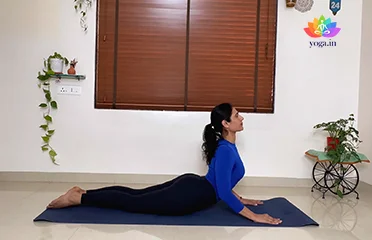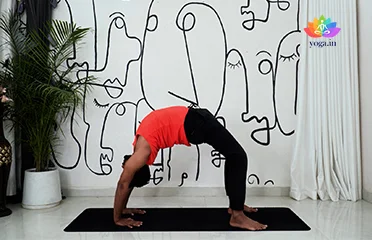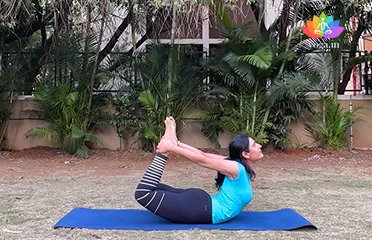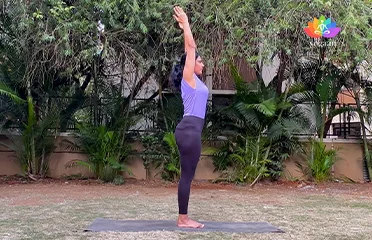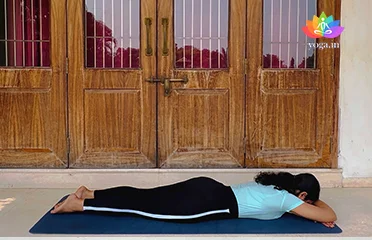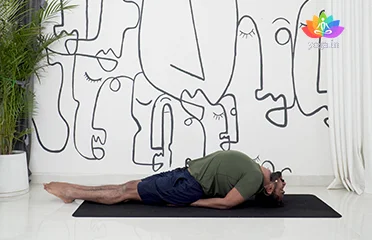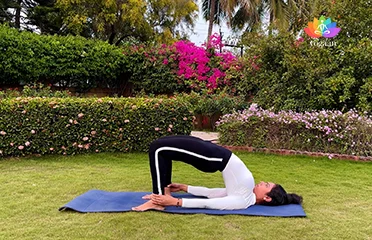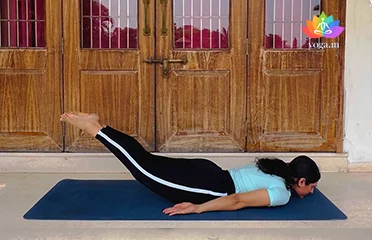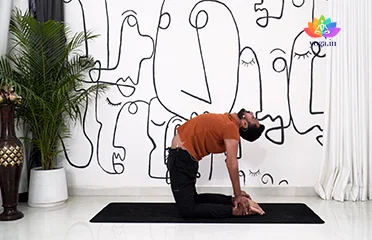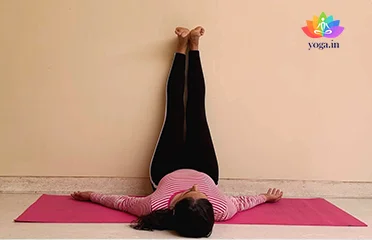Bhujangasana (Cobra Pose)
भुजंगासन / Cobra Pose
The Sanskrit name is derived from Bhujanga (भुजंगा) meaning cobra [�K]
Chakrasana (Wheel Pose)
चक्रासनI / Wheel Pose
The Sanskrit name is derived from Chakra (चक्रा) means wheel and asana [�K]
Dhanurasana (Bow Pose)
धनुरासन / Bow Pose
The Sanskrit name is derived from Dhanur (धनुर) means bow and Asana [�K]
Hastapadasana (Hand to Foot Pose)
हस्तपदासन / Hand to Foot Pose
The sanskrit name is derived from hasta (हस्त) means hands, pada (पदा) [�K]
Makarasana (Crocodile Pose)
मकरासन / Crocodile Pose
The Sanskrit name is derived from Makara (मकरा) meaning crocodile and [�K]
Matsyasana (Fish Pose)
मत्स्यासनI / Fish Pose
The Sanskrit name is derived from Matsya (मत्स्या) meaning fish [�K]
Setubandhasana (Bridge Pose)
सेतु बन्धासन / Bridge Pose
The Sanskrit name is derived from Setu (सेतु) meaning bridge, Bandha [�K]
Shalabhasana (Locust Pose)
सलभासन / Locust Pose
The Sanskrit name is derived from Shalabha (शलभा) meaning locust and [�K]
Ushtrasana (Camel Pose)
उष्ट्रासनI / Camel Pose
The Sanskrit name is derived from Ushtra (उष्ट्रासनI) meaning [�K]
Viparita Karani (Legs Up The Wall Pose)
विपरिता करणी / Legs Up The Wall Pose
The Sanskrit name is derived from Viparita (विपरिता) meaning inverted [�K]
- 1
- 2
How Yoga Can Help Cure Slipped Disc:
A slipped disc, also known as a herniated or ruptured disc, occurs when the soft inner gel of a spinal disc protrudes through its outer layer. This condition can cause significant pain, numbness, and weakness. Yoga can be an effective tool in managing and alleviating the symptoms of a slipped disc. Through gentle postures, breathing exercises, and relaxation techniques, yoga helps to strengthen the back muscles, improve flexibility, and reduce stress, all of which can contribute to pain relief and healing.
Understanding Slipped Disc:
A slipped disc is a spinal condition where the cushioning disc between the vertebrae pushes out of its normal boundary. This can compress nearby nerves, leading to pain, numbness, or weakness in the back, legs, or arms. It most commonly occurs in the lower back but can also affect the neck and upper back. Slipped discs can result from injury, age-related wear and tear, or improper lifting techniques.
Yoga’s Role in Relieving Slipped Disc:
Specific yoga practices can help manage the symptoms of a slipped disc by promoting spinal alignment, strengthening the core muscles, and improving flexibility. Gentle yoga postures (asanas) can reduce pressure on the affected disc, while pranayama (breathing exercises) and meditation can help manage pain and stress, aiding in overall recovery.
Key Factors Contributing to Slipped Disc:
Several factors can contribute to the development of a slipped disc, including:
- Age: Degenerative changes in the spine due to aging.
- Injury: Trauma from accidents or falls.
- Repetitive Strain: Frequent bending, twisting, or heavy lifting.
- Obesity: Excess weight putting additional pressure on the spine.
- Sedentary Lifestyle: Weak core muscles due to lack of physical activity.
- Poor Posture: Sitting or standing improperly for extended periods.
Symptoms of Slipped Disc:
Common symptoms of a slipped disc include:
- Back Pain: Persistent pain in the lower, middle, or upper back.
- Numbness: Loss of sensation in the affected area.
- Weakness: Muscle weakness in the legs or arms.
- Sciatica: Radiating pain down one leg from the lower back.
- Tingling Sensation: A pins-and-needles feeling in the limbs.
- Limited Mobility: Difficulty bending or straightening the back.
Treatment of Slipped Disc through Yoga and Pranayama:
Yoga and pranayama can be highly effective in managing a slipped disc. Some beneficial practices include:
Specific Yoga Poses:
- Bhujangasana (Cobra Pose): Strengthens the spine and stretches the chest and shoulders.
- Ardha Matsyendrasana (Half Lord of the Fishes Pose): Enhances spinal mobility and relieves tension.
Pranayama Exercises:
- Nadi Shodhana (Alternate Nostril Breathing): Balances the nervous system and reduces stress.
- Sheetali Pranayama (Cooling Breath): Calms the mind and reduces pain.
Diet for Slipped Disc:
A balanced diet can support the healing process. Recommendations include:
- Anti-Inflammatory Foods: Green leafy vegetables, berries, and nuts to reduce inflammation.
- Calcium-Rich Foods: Dairy products, almonds, and leafy greens for bone health.
- Omega-3 Fatty Acids: Found in fish, flaxseeds, and chia seeds to reduce inflammation.
- Protein: Lean meats, beans, and lentils for muscle repair and growth.
- Hydration: Drink plenty of water to keep spinal discs hydrated and healthy.
Caution for Slipped Disc:
While practicing yoga for a slipped disc, it is essential to:
- Avoid Overexertion: Practice gentle poses and avoid pushing your limits.
- Listen to Your Body: Stop immediately if any pose causes pain or discomfort.
- Consult with a healthcare provider before starting any new exercise regimen, especially if you have severe symptoms.
Contraindications for Slipped Disc:
Individuals with a slipped disc should:
- Avoid High-Impact Yoga Practices: Vigorous exercises may worsen symptoms.
- Steer Clear of Certain Poses: Avoid deep backbends and twists that can strain the spine.
- Seek Professional Guidance: Consult a yoga therapist or healthcare professional for personalized recommendations.


